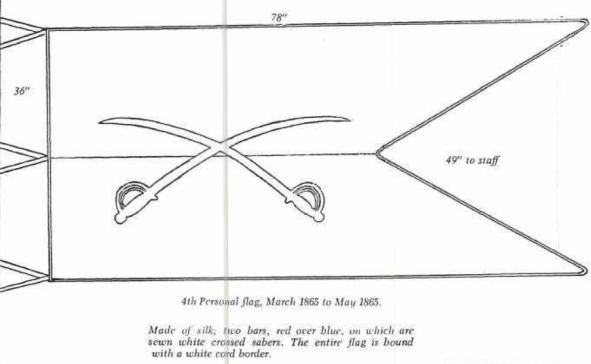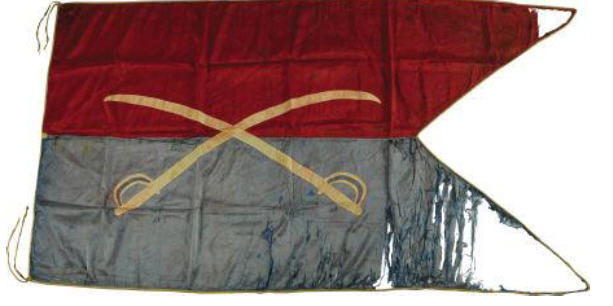|
Known Personal Custer Guidons of the Civil War Period
There were only four known and documented personal guidons used by General George Armstrong Custer during the Civil War. As far as is known and documented Custer never lost a personal standard during the Civil War. (There were two other possible guidons attributed to Custer after the Civil War when he was dispatched to the West to fight in the Indian Wars.)
1st Personal Guidon - Late Summer 1863 to October 1863
(Size: 29.5" X 48" = 74.93cm X 121.92cm) This personal command flag was only flown when Custer was on the battlefield. It was usually carried by a trooper who followed closely behind Custer throughout the battle. It has therefore sometimes been called his Headquarters flag. The actual "Headquarters Colours" would have been another guidon carried by the Third Cavalry during battle, most likely a version of the standard Union Cavalry Guidon.
|
|
Personal Guidon drawing by H. Madaus |
No known phonograph currently available |
2nd Personal Guidon - October 1863 to June (or Sept.) 1864
(Size: 35”X 52”= 88.9cm X 132.8cm) A modern reproduction image of this flag can be found on the Chart of Northern Regimental and Unit Flags (far left).
|
|
Personal Guidon drawing by H. Madaus |
Photo by Historical Society in Monroe, Michigan |
3rd Personal Guidon - September 1864 to February 1865
(Size: 32”X 72”= 81.28cm X 182.88cm) This 3rd personal guidon was handmade by the wife of General Custer, Libby Custer, in 1864. This was one of Custer's more famous flags, as it served with him in the Civil War while commanding the US 3rd Cavalry Division from 1864-65. After the war, it was sent to his home in Monroe, Michigan. Upon his death at the Little Big Horn, it was given by Libby to his brother, and kept it in the family until it was sold at auction 130 years later.
|
|
Personal Guidon drawing by H. Madaus |
Photo from Butterfield & Butterfields |
4th Personal Guidon - March 1865 to May 1865
(Size: 36”X 78”= 91.44cm X 198.12cm) This 4th personal guidon was also handmade of silk by Libby Custer during the final days of the Civil War and delivered to him in the midst of Battle at Dinwiddie Court House near Petersburg,
Virginia on March 31, 1865. This flag was carried as he led his troops through the
breastworks of Confederate General George Pickett at the battle and instrumental in bringing about Lee's
surrender to Grant at Appomattox Court House a few days later. Fortunately for its future survival, in 1876 it was left behind at Custer's headquarters at Fort Abraham Lincoln in the Dakota Territory as Custer and the Seventh Cavalry rode to their deaths at the Battle of Little Bighorn, thus preserving the flag.
 |
 |
Personal Guidon drawing by H. Madaus |
Photo from Heritage Auction Gallery |
Custer was the youngest man given the rank of Major General in US military history, but when the US Army was downsized in 1866, Custer, because he lacked seniority and time in rank was temporarily reduced to his last permanent rank of Captain. Because of his outstanding war record, he was soon promoted up to Lt. Colonel and placed in command of the newly formed 7th Cavalry. Unfortunately, "Custer's Last Stand" and his political ambitions would would soon overshadow and destroy all his many accomplishments.
Information and drawings compiled from the work of Howie Madaus
The source for Howie drawings is: Military Collector and Historian
Published by: Company of Military Historians, Spring 1968, Washington, DC.
Madaus, H. Michael, "The Personal and Designating Flags of General George A. Custer, 1863-1865"
|